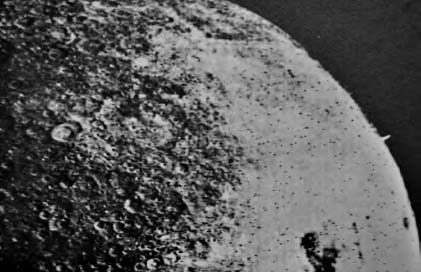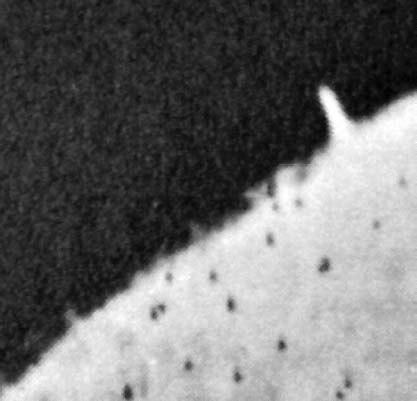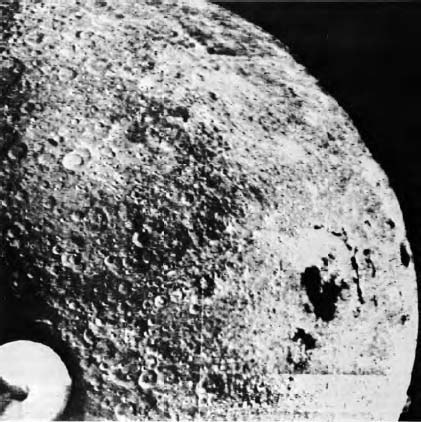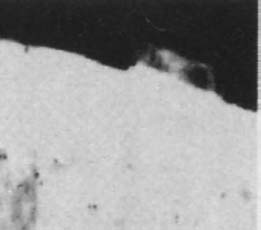Read Ancient Aliens on the Moon Online
Authors: Mike Bara
Ancient Aliens on the Moon (13 page)
Screen capture from NASA film Pinpoint for Science (left) and from Apollo 14 photo AS14-66-9301, showing the same angled, structural buttresses over the horizon from 2 different lunar landing sites. The Apollo 12 Lunar Module Intrepid is visible on the left.
After having an NSSDC 16mm print of
Pinpoint for Science
transferred to video, screen grabs were made and enhanced from the resulting video in the computer. The enhanced 16mm frames unquestionably revealed more of the reflective, glass-like ruins over the horizon from the Apollo 12 landing site, and the same massive inclined buttresses, slanting down beyond the lunar horizon in the distance. Bright star-like objects sparkled amid the amazing, steeply-pitched, stair-stepped lunar ruins, still attached to the visible but shattered geometric framework of the once vast lunar scaffolding that stretched miles overhead.
Given that two Apollo missions, 14 and now 12, had photographed the
same
crystalline geometry from two different locations and using two different photographic methods (70mm photographs and 16mm film), it’s safe to say that we’ve found the ground truth we are looking for. But there is so much more…
It’s not unreasonable to ask at this point why the Russians haven’t ever chimed in on the subject. While they never actually put a man on the Moon, they certainly sent plenty of unmanned probes and those probes carried cameras, just as the NASA missions did. Unfortunately, much of the data gathered by a variety of Soviet space probes was (and still is) inexplicably off-limits to researchers from the West. Even after the Cold War officially ended, the flow of data from Russia did not expand, and at one point a private researcher was told in no uncertain terms to stop looking for lunar data from the Soviet era.
However, over the years a few choice items have emerged in the West. Back in the mid 1960’s, the Soviet’s had created the Zond series of spacecraft which were designed to conduct flyby’s of various planets, including the Moon, Venus and Mars. Even by the standards of the time, the Zond probes were somewhat primitive, lacking the ability to place themselves in orbit around their intended targets and carrying cameras that were well below the quality of the instruments on American probes like the Lunar Orbiter series. Zond 1 and Zond 2 were initially successful, being sent to Venus and Mars respectively. It was thought in the West that Zond 3 was intended as a companion mission to Zond 2, and that perhaps the two spacecraft were intended to meet up in orbit around Mars. However, for reasons unknown, Zond 3 missed its launch window in 1964 and was instead launched in 1965 on a Mars trajectory, even though Mars was no longer in the same location. As a result, it was useful only as a guidance/telemetry test vehicle, and its only real data would be acquired in the flyby of the Moon that was needed to place it on a Mars orbit trajectory.

Zond 3 photo showing 20-mile high tower west of Oceanus Procellarum.

The 20 mile-high Zond 3 tower in close-up.
As it passed by the Moon with a closest approach distance of some 5,716 miles, the Zond 3 spacecraft snapped 23 photos and took 3 spectral images of the lunar far side. Centered mostly over the Mare Orientale impact basin, most of the images were fairly non-descript. But two stood out as completely remarkable. The first image (frame 25) was first published in defense contractor TRW’s
Solar System
Log
magazine in 1967. It shows yet
another
tower, sticking straight up from the lunar surface along the visible limb of the Moon.
This remarkable object is actually anchored somewhere over the horizon, near the towering structures on the western edge of Oceanus Procellarum that were visible from the ground by Apollo’s 12 and 14. Again, by definition such an object (which is at least 20 miles high)
has
to be artificial because no natural object could be standing upright against the incessant meteoric rain of the last 4.5 billion years of the Moon’s existence.
Close-up enhancements of the image shows that not only does the Zond 3 tower appear to be anchored at a point over the horizon, there are some odd and very geometric looking objects next to it. Again, a natural looking lunar horizon should be very smooth, not broken up as the area around the tower is, and of course nothing like the tower should be there at all…
The next Zond 3 image, taken thirty-four seconds later, had no tower visible at all, indicating it had, by that time, slipped over the lunar horizon due to the fast moving Soviet spacecraft’s’ motion and direction. After the tower vanished out of view, it was immediately replaced by an equally anomalous feature, found on image frame 28.
The second amazing Zond 3 shot was originally found in an official NASA publication,
Exploring Space with a Camera
(NASA SP-168, 1968), but is now available in high-resolution on the internet.
Located on the lunar horizon approximately a thousand miles further to the south, a large, eroded dome-like structure was plainly visible in the lower right corner of the image. Again, this “Zond 3 dome” extended several miles above the airless lunar horizon against black space. And, like the earlier “Zond tower,” neatly aligned with the local vertical.
A close-up of this second Zond 3 dome reveals a significant amount of deterioration, undoubtedly due to long term exposure to the effects of meteor erosion. That said, the outline of a very geometric, structural building extending miles above the Moon is still clearly defined. Above the dome, the smaller remnants of what appears to be a lattice work type structure are visible under enhancement. Based on this, I suspect that what Zond 3 captured was in fact the battered remains of a watch crystal type of dome just beneath the larger protecting scaffolding we’ve seen other places on the lunar surface. Such an arrangement would provide an ideal engineering solution to the long-term issues involved with lunar habitation. Without an atmosphere to protect it from even the most mundane, everyday kinds of meteor strikes, a lunar base would stand little chance of surviving beyond a few years. But with a multilayered, miles-high scaffolding structure at the top and then smaller reinforcing “watch crystal” domes underneath, a lunar base might conceivably survive for hundreds of thousands if not millions of years.

Zond 3 photo showing massive dome in lower right-hand corner.
But there is ground truth, and then there is ground truth. The next obvious question is if these towering structures were all around the astronauts as they descended to and then explored the lunar surface, why didn’t they
see
them? And if they did, why then did they not comment on them?

Close-up of the lunar “dome”—from Zond-3 (July 20, 1965).
The first question is actually the easier one to answer. But the second one is the more revealing. After all, what if they did see these structures, but somehow just
forgot
that they did?
If in fact there are these towering glass structures all over the Moon, scattering the light in geometric patterns all over the place, as in the Apollo 14 “Mitchell Under Glass” panorama, then that would go a long way to explaining the numerous reports of Transient Lunar Phenomena over the years. Instead of unlikely “outgassing” events, the observers were merely seeing specular reflections of specific panes of glass over the lunar surface. When the Moon moved a little bit, the phase angle of the reflected sunlight changes and the brilliant flashes of light go out. But this does not explain the odd changes in color that were observed repeatedly over the centuries. What could cause them?
Well, when light hits a glass surface, it tends, depending on the shape of the glass, to be bent and/or distorted. But, the glass doesn’t stop the ray of light, although it might change its direction. The effect is the same as if you shined light through a glass prism.
In addition to reflection, the other hallmark signature of glass is its ability for refraction—to bend light by slowing it down as the light passes through the glass. But light doesn’t slow down (bend) uniformly when entering or leaving a transparent medium, like glass. It bends selectively, depending on the wavelength and the angle. This is the basic physics of a prism. Higher frequencies (shorter wavelengths, like blue and violet) are slowed down more. Thus, they are deflected through a greater angle of “dispersion” than lower (longer) wavelengths, like orange and red.
This results in the classic “rainbow” seen after light has passed through anything transparent, including glass, water droplets, ice, quartz crystals, or any refractive medium capable of differentially bending (slowing down the velocity of) light, compared to its velocity in a vacuum.
So if there really were massive amounts of transparent (glass) material on the surface of the Moon, the one
proof
of that hypothesis would be that the lunar surface below (and remnants of the structures above) should be all the colors of the rainbow, and all the colors in between. We should see not just red, green and blue, but pink and purple and yellow. But, didn’t astronauts uniformly describe the Moon’s surface as grey and colorless, a “magnificent desolation” of blandness? And didn’t the pictures that were returned show the same thing?
Well, yes. But if you look at most photos of the astronauts on the lunar surface from that era, you’ll also notice that the colors on their spacesuits are inexplicably faded. The fact is that most of these images have had the color toned down on them, to reflect the NASA position that the surface of the Moon is bland and nearly colorless. All you have to do is turn up the volume on the color, by increasing the saturation, and a whole different picture emerges.
Images, like the one below (NASA frame AS17-137-20990) show that not only is the lunar surface multi-colored, but those colors vary from place to place, just as they would if sunlight were being scattered by the towering glass structures. Instead of seeing a bland grey landscape, the Moon literally comes alive with pink mountains, blue rocks and purple boulders.

